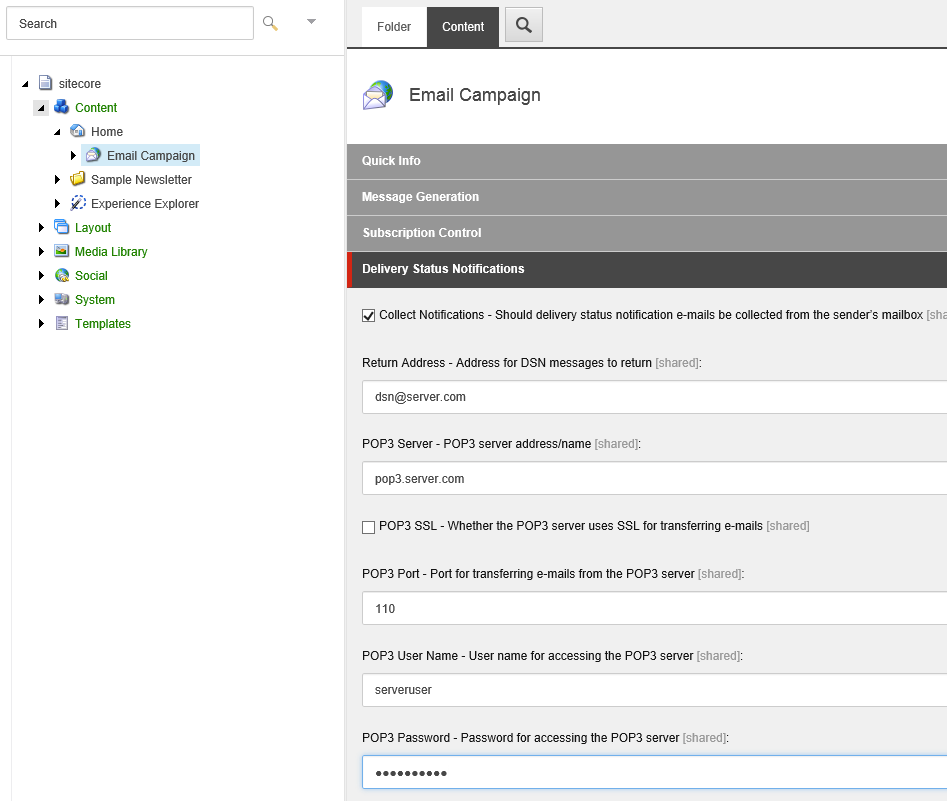The configuration settings for collecting bounces
The Sitecore Application Center collects delivery status notifications when the message delivery fails and passes them to EXM.
If an error occurs during email delivery, the sender receives a bounce from the sender's mail server or from the recipient's mail server. When a server accepts a message for delivery, it also delivers a bounce if the delivery fails.
EXM uses one of the following methods to collect bounces:
By default, EXM collects the bounced email campaigns on a scheduled interval using the Sitecore.EDS.Providers.Sparkpost.Tasks.PullBouncesAgent setting in the <scheduling> section in the Sitecore.EDS.Providers.Sparkpost.Sync.config file.
<agent type="Sitecore.EDS.Providers.Sparkpost.Tasks.PullBouncesAgent, Sitecore.EDS.Providers.Sparkpost" method="Run" interval="01:00:00"> … <runInterval>01:00:00</runInterval> <messageEventsCount>500</messageEventsCount> </agent>
Setting | Default value | Description |
|---|---|---|
interval | 01:00:00 | Specify the interval for when you want the Sitecore Email Cloud to collect the bounces. |
runInterval | 01:00:00 | Specify how far back from when you start the Sitecore Email Cloud provider that you want EXM to collect bounces. |
messageEventsCount | 500 | Specify the default page size for the Sparkpost API. By default, 500 is the maximum number of records that is returned at a time. The value must be between 1 and 10.000. ImportantThis setting must correspond to the limit that is set in the Sparkpost API. |
If you use a custom SMTP, you can configure the bounce settings on the manager root, on the Content tab, in the Delivery Status Notifications section.

Setting | Example | Description |
|---|---|---|
Collect Notifications | cleared | Select this check box to collect bounces from the email address that is used to send your email campaigns. Any blank fields will inherit the values from the manager root. If you clear this check box, the system ignores the delivery notification settings and behave as though all messages have been delivered successfully. |
Return Address | dsn@site.net | Specify the email address that you want the service to send bounces to. |
POP3 Server | pop.server.com | Specify the POP3 server address/name. (mandatory) |
POP3 SSL | default | Select if you want to the POP3 server to use SSL for transferring email campaigns. |
POP3 Port | 110 | Specify the port for transferring messages from the POP3 server. (mandatory) |
POP3 User Name | serveruser | Specify the POP3 server user name. |
POP3 Password | 12345 | Specify the POP3 server user password. |
The bounces are collected on a scheduled interval using the setting Sitecore.EDS.Providers.CustomSmtp.Tasks.PullPop3BouncesAgent in the <scheduling> section of the Sitecore.EDS.Providers.CustomSmtp.Sync.config file.
<agent type=" Sitecore.EDS.Providers.CustomSmtp.Tasks.PullPop3BouncesAgent, Sitecore.EDS.Providers.CustomSMTP" method="Run" interval="00:01:00"> <param ref="exm/eds/receiversCollection" /> </agent>
Setting | Default value | Description |
|---|---|---|
interval | 01:00:00 | Specify the interval during which you want the custom SMTP to collect the bounces. |
The PullPop3Bounces agent uses the exm/eds/receiversCollection element to get POP3 settings. The ManagerRootsPop3ReceiversCollection is used by default. This retrieves POP3 settings as specified on each manager root in Sitecore.
The alternate Pop3ReceiversCollection implementation uses the POP3 settings that are specified in the Sitecore.EDS.Providers.CustomSMTP.Sync.config file. You can also implement your own receiversCollection.
Here is an example that uses the alternate Pop3ReceiversCollection implementation:
<pop3Settings>
<pop3Setting type="Sitecore.EDS.Core.Net.Pop3.Pop3Settings,
Sitecore.EDS.Core" singleInstance="true">
<server>localhost</server>
<port>110</port>
<userName>username</userName>
<password>pwd</password>
<useSsl>false</useSsl>
<startTls>false</startTls>
<proxySettings ref="exm/eds/proxySettings"/>
</pop3Setting>
<pop3GmailSetting type="Sitecore.EDS.Core.Net.Pop3.Pop3Settings,
Sitecore.EDS.Core" singleInstance="true">
<server>pop.gmail.com</server>
<port>995</port>
<userName>your@gmail.com</userName>
<password>password</password>
<useSsl>true</useSsl>
</pop3GmailSetting>
</pop3Settings>
<receiversCollection
type="Sitecore.EDS.Providers.CustomSmtp.Reporting.Pop3ReceiversCollection,
Sitecore.EDS.Providers.CustomSmtp">
<settings hint="list:AddSettings">
<setting ref="exm/eds/pop3Settings/pop3Setting"/>
<setting ref="exm/eds/pop3Settings/pop3GmailSetting"/>
</settings>
<param ref="exm/eds/bounceInspector"/>
<param ref="exm/eds/environmentIdentifier" /
<param ref="exmLogger" />
</receiversCollection>